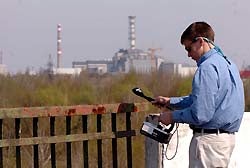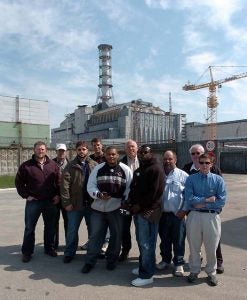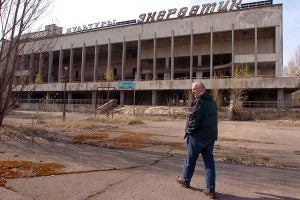Silent, stunning Chernobyl stirs emotions for ECU group
KIEV, UKRAINE — A group from East Carolina University traveled today to the site of the world’s worst nuclear meltdown and the deserted towns nearby and came away with increased respect for the power of the atom.
The six students, three faculty and two staff members visited the shuttered Chernobyl nuclear power plant, about 80 miles from here, taking radiation readings as close as 250 yards from the destroyed Unit 4 reactor and the deteriorating sarcophagus that encloses it.

ECU graduate student Chris Henry takes radiation readings on a bridge near the Chernobyl nuclear power plant. Photos by Cliff Hollis
The group also walked through the silent “ghost-town” of Pripyat, the city built in 1970 approximately a half-mile from the reactor as the new, modern home of those who worked there. Leaves blow down empty streets, radioactive moss grows on the sidewalks and an amusement park that once hosted laughs and smiles sits rusting and still.
“I was stunned,” said Dr. Daniel Sprau, the ECU associate professor of environmental health who organized and led the trip. “What struck me was Pripyat, the quietness of it, the sheer volume of lives that were destroyed.”
On April 25, 1986, the Unit 4 reactor at the Chernobyl station was scheduled to be shut down for routine maintenance. Officials decided the shutdown would be a good time to conduct a test to see if inertia would keep the turbines spinning long enough, in case of a power failure, to operate pumps that circulate water to cool the reactor until diesel generators kicked in. A similar test had been successfully carried out before on another reactor.
Inside a nuclear reactor, enriched uranium is broken down in a process called fission that creates massive amounts of heat. The heat boils water into steam, which powers turbines to generate electricity.
In shutting down the reactor for the test, operators reduced power too much, too quickly. They then increased power, but not to the normal amount for this experiment. Nevertheless, at 1:23 a.m., they began the test. Versions vary on the exact sequence of events that led to the disaster, but suffice to say that a series of missteps made worse by the disabling of several safety mechanisms for the test caused the reactor to surge out of control.
A steam explosion inside the reactor blew off the 2,400-ton reactor lid; it landed on its side on top of the reactor. The explosion also blew off the roof of the reactor building, spewing radioactive material into the atmosphere. Air rushed in, igniting graphite inside the reactor. The fire burned nearly four hours as helicopters dumped sand and lead to extinguish it and firefighters struggled to contain it.
For the first day or so after the explosion, plant officials said only that a problem had occurred at the reactor, and no one should be concerned. But with radiation levels so high they didn’t even register on the meters officials used, and with firefighters and plant employees dying of acute radiation poisoning, officials ordered the evacuation of Pripyat’s 50,000 people April 28. They were told the evacuation was temporary, and many left with just the clothes they had on and a bit of food and money. They never returned.
The United Nations reported last year that 56 people — 47 workers who died of acute radiation exposure and nine children who died of thyroid cancer — died as a direct result of the explosion, and another 3,940 people could die prematurely of cancer caused by radiation exposure. Greenpeace, on the other hand, released a report this month estimating 93,000 people have died or will die from Chernobyl.
The scale of the disaster and its aftermath — altered lives and deserted towns — struck students.
“It definitely gives me a new perspective on nuclear power,” said Chris Fletcher, who will graduate this summer with a master’s degree in environmental health. Before, he said, he was curious about nuclear power but hadn’t lived near a reactor or thought about it much. “It needs to be handled very carefully.”

ECU students, faculty and staff visited the Chernobyl nuclear power plant April 27. They are, from left, Chris Fletcher, Dr. Rick Kilroy, Eric Ferrell, Doug Boyd, Kenneth Dingle, Dr. Dan Sprau, Leonard Robinson, Michael Apple, Dr. Larry Toburen and Chris Henry.

Dr. Daniel Sprau walks past an abandoned building in the empty town of Pripyat, evacuated after the 1986 explosion at the Chernobyl nuclear power station.